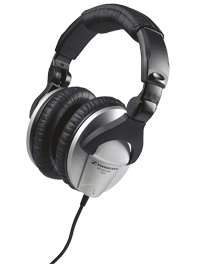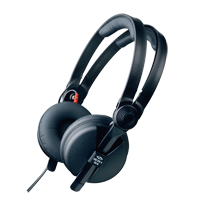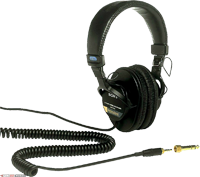 Q It Up: What headphones do you use in the studio? What do you like about this pair? Do you use headphones to mix? Do you think mixing with headphones is a good or bad idea, and why?
Q It Up: What headphones do you use in the studio? What do you like about this pair? Do you use headphones to mix? Do you think mixing with headphones is a good or bad idea, and why?
Liz Brace [
 Johnny George [
Johnny George [
I bought two pair in 1993 for my first home studio. They were 125.00 each back then. One got damaged by an overly energetic user, who will remain nameless, and the other pair just started showing signs of wear about the time I left radio in 2006. Since then, I’ve been using another pair of K240’s that used to belong to the late, veteran voiceover God, Billy Moore. I inherited his headphones and have been using them ever since.
I still love them and it keeps the spirit of Billy alive with me in my JGC DigiStudio.
BTW… the new Sennheiser HD 800 headphones that retail for 1399.99… WHO is going to pay THAT for a pair of headphones? If you’ve heard them, please enlighten me… and your income.
Dennis Mattern [
Rarely use headphones to mix. Unless the building is unusually noisy or crowded and I need to escape.
Depends on the individual. Using headphones can improve your overall focus.
 Ric Gonzalez [
Ric Gonzalez [
Back to mixing. I seldom mix with them on. I use the monitors or small close range speakers. I think mixing with your headphones on can be bad if you’re one of those folks who cranks your cans up too loud. Then it’s like mixing with your production room monitors blasting. Nobody listens to commercials that way. This is why I usually check the final mix on a cue speaker.
But if I am doing post prod on a commercial at my desk, sometimes I wear my headphones out of kindness to the offices next to mine… engineering on one side and promotions on the other. They don’t need to hear me mix a commercial for a breast enhancement cream.
If I mix at home late at night, I sometimes do so with my headset. My son’s bedroom is on the other side of the wall.
Now… about “voicing” with headphones on….
 Rob Maurer [
Rob Maurer [
I never use them to mix... no one should solely use headphones to mix, in my opinion. No matter how “flat” your cans are claimed to be, everything is hyped in them, or drastically cut (in the case of the low, low-end) making it virtually impossible to get a proper sonic balance. You can get “in the ballpark” on cans, or use them as a starting point (especially as our mixing rooms go more and more mobile), but that’s about it.
Todd Franklin [
Andrew Frame [
 Mitch Todd [Mitch
Mitch Todd [Mitch
Then, I finally switched to Sony MDR-7506’s and haven’t changed since. However, I have never used headphones for critical judgments, like mixing. They’ve always been a utilitarian device for monitoring where monitors aren’t practical or an option.
Finally, I feel I’m a bit of a traditionalist as well when it comes to mixing, in that headphones should generally NOT be used for that purpose unless you have no choice. But I don’t like ear buds or even listen to music with “cans”, so perhaps I’m just “old school” (I also prefer using faders)!
Steve Stone [
So I bought the cheapest things I could find at World-Mart. Sony mdrV150. You know, the ones that always break in the same place just above one ear! Anyway, over the years I’ve tried some others and I keep going back to the $19 specials. They’re cheap, every World-Mart has them and I like the way they sound. Although I know that I’d love them, I just can’t bring myself to splurge for some Bose. As far as mixing, I will do rough mixes with cans, but always do final mixes through good speakers.
Wally Wawro [
I mix all the musical entertainment for our weekday morning show, Good Morning Texas. Because the show originates from a remote “showcase” studio, my challenge is to mix at a distance of 10-12 feet off camera from whoever is performing. Headphones that isolate well are a must since I’m getting pounded with 90-100db of audio from whatever band is on the show that day. I started using the AKG 270’s which do the job nicely, but then I’ve switched to Sony MDR-7509HD phones, the big brother to the standard Sony 7506. The Sony phones seem to be standard with live sound guys, and occasionally a band will have their own mixer do that chore (which I’m perfectly fine with), and if they don’t bring their own set of cans, at least I have something familiar available.
I do engineering/production for a number of sports remotes (high school football primarily, which is akin to religion in Texas). For that I need isolation and long term comfort, so the nod tends to go to the Sennheisers I mentioned before, but I have a pair of Beyer consumer phones I bought for $30 that I like a lot.
I look for clarity and comfort in a good set of headphones. And fit is important for me as well since for the last several years I’ve worn “personal communications assistants.” Your friendly neighborhood audiologist will tell you that’s the new way they market hearing aids.
An audio guy with hearing aids! Who da thunk it!
Jeff Berlin [
Travis McGinnis [
To directly answer the question though, I use the good old Sony Studio Monitors (MDR-V600s). They’ve always been my favorite... and for on-air work, I don’t really need anything super fancy or expensive.
When it comes to voicing and producing, the cans stay in my top desk drawer. Voicing with headphones on returns a deceptive sound to my ears -- it makes me want to speak louder and be more “announcery” when I can hear my voice coming back at me.
For production, a good pair of speakers is all you need. Most listeners don’t listen with headphones, so why should I be producing with them? I optimize sound for the listener, not for the studio. Headphones are just another link in that chain which I’d just as soon remove.
Blaine Parker [
I know a lot of former air guys will probably take me to task on this, but I find those big Sony phones that everyone loves to be too heavy and too sizzly — like a Black & Decker drilling through the sheet metal between my ears. That’s really fatiguing. When I’m using phones, there are three different models I currently use. There’s a Sennheiser HD280 Pro for location recording and occasional use in the studio. It’s an affordable, OK sounding circumaural headphone that packs reasonably well. When travelling light but wanting something to use with my iPod or on the occasional “emergency” recording, the Sennheiser PXC250 is a lightweight, noise-cancelling headphone that works surprisingly well and folds up into a pouch. And for “serious” listening when my curmudgeonly inner audiophile demands more, the Grado SR80 comes out. They’re actually rather primitive looking, and aren’t particularly comfortable for long-term wearing. In fact, they look like they were built in John Grado’s garage — and may have been. Doesn’t matter. For a $100 pair of cans, these things sound phenomenal.
Hmm. That seems like a lot of talk about headphones for a guy who just said he doesn’t usually use ‘em…
Jim Knight [
Dan Zullo [
Dave Anton [
2. I don’t necessarily like them, but I use them because they reproduce a more flat response and don’t gussy the sound up at all (after all, I can’t expect every listener to have top-shelf headphones too!?). If the monitors didn’t cut every time I hit my MIC on, I wouldn’t use them.
3. I think mixing with headphones can mask the true sound and give inflated results. Headphones are great to “check” the mix… then again so is using a really bad boom box. Monitors, monitors, monitors.
I’m just sayin’….
♦

